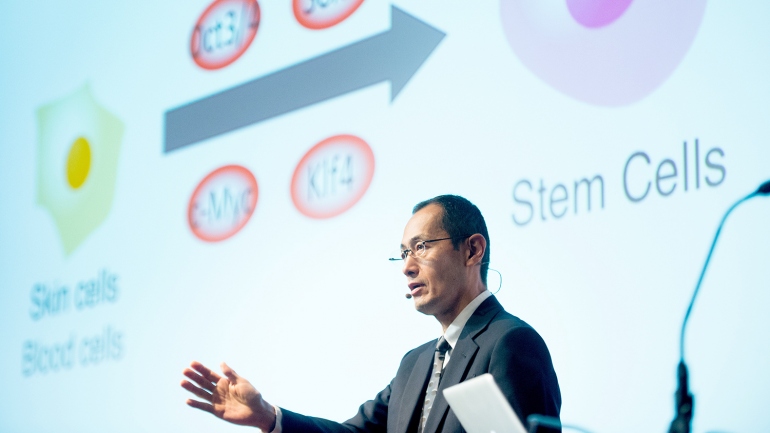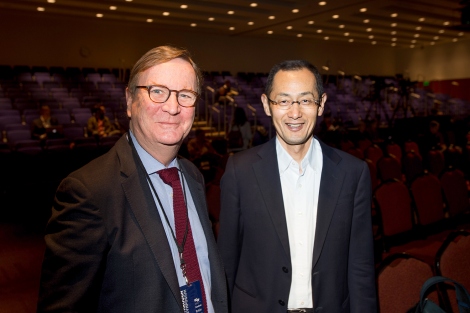Shinya Yamanaka Talks About Driver of His Discoveries at Breakthrough Prize Symposium

Shinya Yamanaka, MD, PhD, began his career three decades ago as a physician, and within a year of becoming a doctor, his father passed away from Hepatitis C acquired during a blood transfusion.
“As a young doctor, I was not able to do anything for my own father,” said Yamanaka, who holds academic appointments at UC San Francisco, the UCSF-affiliated Gladstone Institutes and Kyoto University. “That is the biggest reason why I decided to become a scientist: to overcome diseases.”
Yamanaka, speaking at the 2017 Breakthrough Prize Symposium at UCSF, said that while there is now a cure for Hepatitis C, there are many other diseases and injuries that science has yet to overcome – and the cure for many may not be that complicated, as they are often rooted in the loss of function of a single type of cell, or a few types of cells.
His own studies in determining how to replace dysfunctional cells earned him a 2013 Breakthrough Prize in Life Sciences.

The Breakthrough Prizes honor achievements in fundamental physics, life sciences and mathematics. On Sunday, the 2017 awardees were announced during a star-studded gala. Laureates, who receive $3 million each in prize money, present their work the next day at the Breakthrough Prize Symposium alongside past laureates. Yamanaka's talk was followed by talks and evening panel discussions of topics ranging from Parkinson’s disease to string theory.
“This extraordinary support of science and science education is vital for our country and our world,” said Chancellor Sam Hawgood, MBBS, in his opening comments at the symposium. “It helps us to sustain a thriving scientific community that conducts curiosity-driven research unfettered by financial, commercial or political constraints.”
The Breakthrough Prize was founded by Google co-founder Sergey Brin; 23andMe co-founder and CEO Anne Wojcicki; technology investor and science philanthropist Yuri Milner and his wife, Julia Milner; and Facebook co-founder Mark Zuckerberg and his wife, UCSF-trained pediatrician and philanthropist Priscilla Chan.
“Simply put, investing in science essential for our future,” Hawgood said. Yamanaka, he said, is a prime example of the “time and tenacity” that science demands, demonstrating what a decade of advancements could yield and what a decade into the future might hold.
In 2007, Yamanaka figured out how to create a large supply of many types of functional human cells that grow infinitely using a new type of stem cell, called induced pluripotent stem cells (iPSCs). This breakthrough 10 years ago, for which Yamanaka was the co-recipient of the 2012 Nobel Prize in Medicine or Physiology, turned out to be “very simple” according to him, requiring only four specific ingredients added to the cell growth media.
Using this technology, scientists all over the world are working on applications of iPSCs, including preparing large amounts of functional neurons, retinal cells, erythrocytes and platelets to be used in clinical trials, combining the technology with immune therapy to fight cancer, and using iPSCs for disease modeling and drug screening.
Yamanaka discussed the current work with iPSCs and the potential in his talk at the symposium that was titled “Recent Progress in iPS Cell Research and Future Applications.”
The Breakthrough Prize is now in its fifth year. The symposium, co-hosted by UCSF, UC Berkeley and Stanford University, rotates between each campus.
“We commend and thank the prize founders,” said Hawgood, “for their vision and leadership in establishing these prizes, which inspire future generations to explore and expect the unexpected.”